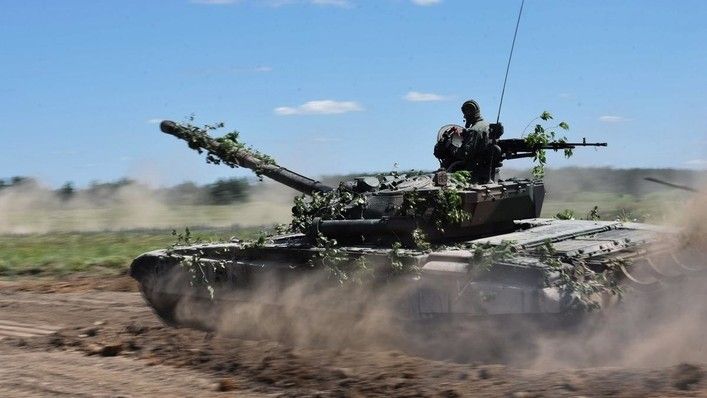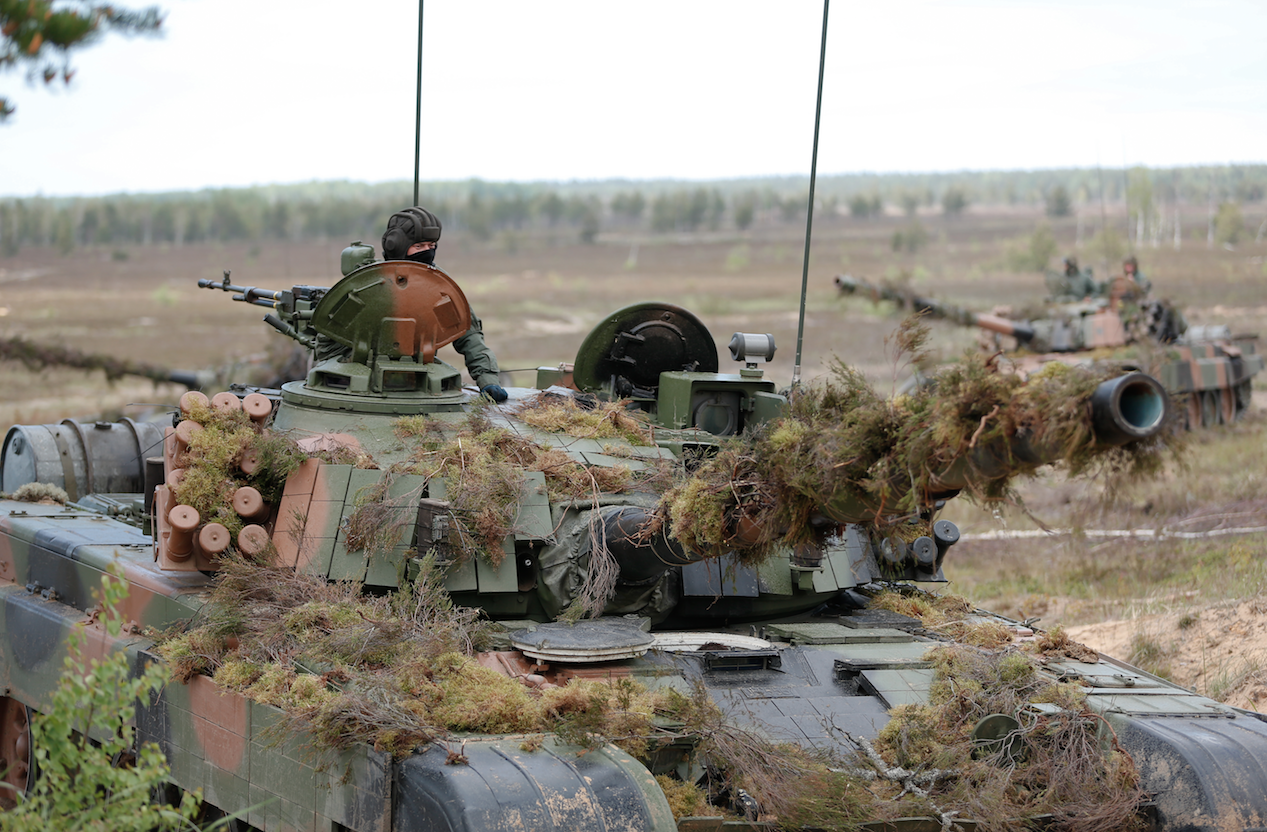Strona główna
Polish Guided Missiles for T-72 Main Battle Tank?

The agreement signed, concerning the general overhauls and modification of the T-72 main battle tanks, will make it possible to recover the availability and improve observation and communications capabilities of the vehicles. However, the programme does not solve the burning problems related to the obsolete ammunition available for the T-72 and PT-91 platforms. A concept was created by the Polish industry to increase the firepower by developing a new ATGM that could be launched out of the tank’s main gun.
T-72 - Modifications
Currently the Polish military operates around 250 to 300 T-72M1 and 232 PT-91 TWARDY main battle tanks. The tanks in question are used by 8 out of 12 main battle tank units and thus they constitute two thirds of all of the main battle tanks used by the armoured elements of the land forces, along with 247 Leopard 2A4/A5 main battle tanks used by the remaining 4 battalions. Considering the reasons above, the tanks mentioned here are an important element of the Polish Military’s “armoured fist”, available in case of a potential conflict.
Firepower, however, is the main and the most important factor remaining decisive for the effectiveness of that force. Firepower is complex, and its final shape involves numerous components, such as the targeting/observation systems, fire control system, turret stabilization, gun and its stabilizer, and, above all, the main effector: ammunition. The upgrade approved assumes that solely the observation/targeting system would be modified via retrofitting a new thermal vision camera that would decisively enhance the night/all weather observation capabilities. Other crewmembers would also receive new passive night vision systems.
Due to budgetary constraints and the “gap-filler” profile of that design, limited scope of modification is understandable. However, should it be assumed that the modified T-72 main battle tanks recover more of their combat value, firepower should be enhanced through introduction of new type of anti-tank rounds.

T-72 Main Battle Tank Ammunition
Currently, BM-15 rounds, among other, post-soviet types of munitions, constitute the bulk of ammunition available for the T-72 and PT-91 tanks. Noteworthy, those rounds have been designed with 2nd generation MBTs in mind, as their primary targets (Chieftain, Leopard 1, M60 Patton). Those vehicles feature a cast, monolithic armour. The ammunition would not be as effective against modern replacements (Challenger 2, Leopard 2, M1 Abrams) with modern multi-layered armour. The rounds in question are also used for training purposes. They are also being exported. Their effectiveness has been very insignificant back in the 1980s. Not only are those rounds inferior when compared to the modern designs, they also offer capabilities weaker than the ammunition used by NATO and former USSR towards the end of the Cold War.
Requirement to replace this ammunition has been noted in mid 1990s. This resulted in an intention to acquire relevant offset technology, with that acquisition expected to happen alongside the Spike-LR ATGM procurement. Ultimately, only a small batch of “Ryś” rounds has been manufactured back then. This means that soviet rounds are still the basic anti-tank tool used by the Polish main battle tank crews. The armour worn by the Russian main battle tanks is also being continuously refined, along with the T-72B3M and T-80BVM upgrades for instance. It is dubious then whether the “Ryś” round would be able to neutralize the aforesaid platforms if they were hit where the armour is the thickest (front of the turret/hull) and where extra ERA protection is provided.
Development of a potential T-72 replacement may take around a decade or longer, considering the time needed to define the requirements, carry out the R&D effort or manufacturing and introduction into service. The above means that these tanks would not enter active service at least until 2030. For that reason, the agreement signed with regards to repairs and modification should be extended with extra annexes ASAP. Further modifications should be aimed at boosting the firepower, at the best cost-effect ratio, which would translate into a necessity of acquiring a new type of anti-tank rounds. Without this type of rounds the tanks would suffer from being less than effective on the modern battlefield, even in a role of fire support platform/tank destroyer.
Guided Munitions for T-72
Responding to the aforesaid demand pertaining to the new anti-tank rounds, the Polish defence industry began its own R&D effort concerning the subject matter discussed by the present article. CRW Telesystem-Mesko Sp. z o. o. can be found among the entities proposing their solutions of the problem. The company is known, primarily, for its research in high tech domain with regards to optronics and electronics. CRW Telesystem-Mesko develops systems such as autopilots, IR-seekers, laser guidance units for PGMs, laser target designators for semi-active laser guidance weapons, and gyroscope systems.
All of the solutions developed can be easily utilized when designing a new guided, bore-fired anti-tank round (125 mm calibre, suitable for the T-72 tanks family). Utilizing this type of solution would allow for gradual improvement of effectiveness and universal profile of the firepower offered by the T-72M/M1 main battle tanks. Furthermore, system of this kind would also offer a certain export potential.
The new anti-tank guided munition is to offer semi-active laser guidance allowing for hitting targets effectively at distances of 5000 meters, with 17 seconds defined as flight time at that maximum range. The system includes an ATGM, 125 mm tank gun adopted for launching such missile, and control system in the turret, operated by the gunner. A tandem warhead would make it possible to penetrate 750 mm of armour covered with ERA. The missile is to weigh up to 30 kilograms. Its main section is 675 mm long and the rear section is 408 mm long. It is expected that the missile would be operable within the temperature range between - 40 up to +60 degrees centigrade.
The use method can be described as follows: After the target is detected at a distance closer than 5000 meters, it is possible to use the ATGM to destroy it. “Start” [Launch] button is pressed to launch the missile. Its base is jettisoned and wings unfolded. The projectile follows the laser beam that guides it towards the target and the gunner has to place the sight on the target until the missile hits it.
The main advantages of the missile are many:
- Interference resistance provided thanks to guidance system and proper projectile design,
- Precise hits are possible thanks to a digital guidance system coupled with a dynamic electronic ailerons control system used to implement new control method,
- Universal use profile - the weapon can be used against vehicles, fortifications or even helicopters,
- Increased penetration capability ensured thanks to the modular design,
- Ability to act against the enemy targets outside the envelope of most of the analogous weapons, thanks to the extended range,
- Complete resistance to jamming,
- Lack of maintenance needs during use or storage,
- Good cost-effect ratio.
Summary
New bore-fired ATGM for the T-72 main battle tanks seems to be a solution that could decisively improve the firepower that those vehicles offer. The main battle tanks would obtain an ability to precisely act against armoured threat, also at longer distances, with the use of guided munitions. When compared to the currently used solution, a round as such would also ensure a much greater penetration, ERA included.

On the other hand, despite the effort undertaken by many nations, concerning bore-launched ATGMs, solely Israel, alongside Soviet Union (Russia and Ukraine still using systems as such on T-72s), decided to develop a tank-bore-launched LAHAT ATGM with subsequent introduction into the inventory available to the military. Countries that have the western-made main battle tanks at their disposals consider the accuracy and effectiveness of the contemporary APFSDS rounds to be sufficient when direct hit is possible (with the latest ammo types being taken into account, when fused with refined guns and fire control systems). To achieve similar results in case of the T-72, not only is the gun modified, as better penetration is also allowed by a modified autoloader that makes it possible to use longer cores. On the other hand, some of the analysts suggest that cost of the ATGMs shall be viewed as a factor contradicting the rational side of procurement.
One shall also remember that when one acquires ammunition for the primary platforms (and T-72s would retain this role for at least another decade) then the matter of deliveries and their certainty and options of expanding their scope should also be considered. Furthermore, development and using domestic R&D abilities to further upgrade the munitions in question are also a subject to potential scrutiny. The latter often turns out to be cheaper than importing ammunition from abroad, also providing a developmental impulse for further refinement of the know-how at hand, also with regards to other platforms. Lastly, T-72 Main Battle Tanks may need more than one type of modern ammunition, so that the rounds match the threats encountered. Undoubtedly, both PT-91 as well as T-72 MBTs, need to, urgently, receive new, modern rounds that would allow the aforesaid main battle tanks to effectively neutralize the armoured assets used by the potential adversary.
Mateusz Zielonka
